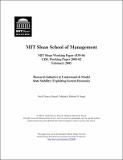| dc.description.abstract | In its Preface, The 9/11 Commission Report states: We learned that the institutions charted with protecting ... national security did not understand how grave this threat can be, and did not adjust their policies, plans, and practices to deter or defeat it (2004: xvi). Given current realities and uncertainties "better preparedness" can be achieved by identifying, controlling and managing the elusive linkages and situational factors that impact state stability and fuel state decay and destruction - and hence create new threats to the nation's security.
We propose to focus on the use of system dynamics modeling techniques to help understand, measure and model the complex dynamics shaping state stability, initially for two regions. We will specifically consider the impacts of unanticipated disruptions, such as a tsunami and its aftermath, on the dynamics of the two regions. For each region, we will deliver a detailed country model, including 3-5 futures predictions in the 6-12 month range along with an analysis of conditions and casual links between predicted futures plus corresponding mitigated options. | en |
